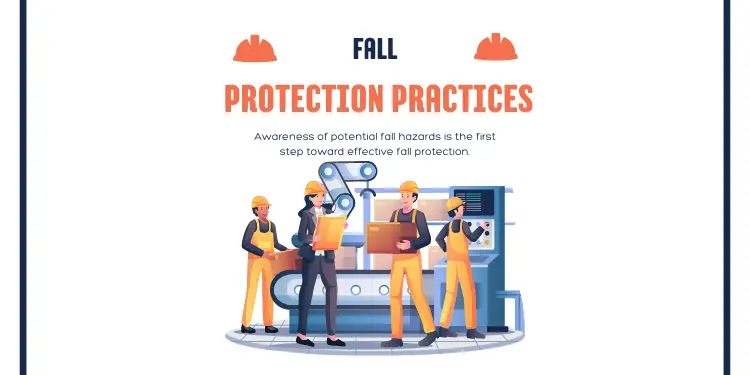Have you ever peered over a ledge and felt your heart leap? For many brave workers, heights are not an occasional venture but an everyday reality. Whether constructing towering buildings, traversing high bridges, or maintaining lofty wind turbines, these daring souls power our world while risking life and limb.
But falls need not be an inevitable part of the job. With careful planning and oversight, accidents can become a thing of the past. As any ironworker or roofer will attest, avoiding plummets requires more than luck – it demands diligent focus on fall safety.
Comprehensive fall protection is crucial. Employers can reduce harm from spills by identifying hazards, properly equipping crews, and consistently training. This blog post will discuss fall protection, its risks, regulations, and requirements to avoid.
Identifying Fall Hazards
Awareness of potential fall hazards is the first step toward effective fall protection. Hazards can come from many sources; identifying them requires a thorough understanding of the work environment.
Types of Fall Hazards
Common fall hazards include elevated surfaces, falling objects, and floor or wall openings. Working at unprotected heights like rooftops, scaffolding, or loading docks puts workers at risk.
Falling tools, materials, or other equipment can be dangerous if not secured above employees. Uncovered holes in floors or walls present tripping hazards and allow falls straight through openings.
Industries that Require Fall Protection
Construction, utilities, manufacturing, and roofing involve frequent work at elevated heights. Within these industries, tasks such as concrete work, steel erection, and window washing often take place far above the ground.
Mining, oil and gas extraction, and agricultural work also regularly expose employees to fall hazards. Proper fall prevention planning is especially important in higher-risk industries and operations.
Causes of Workplace Fall Incidents
Slips, trips, equipment malfunctions, adverse weather conditions, improper or non-existent safety equipment, and human errors can lead to falls. Slipping on spilled liquids, tripping over cords or debris, and losing balance in high winds are everyday slip-and-trip hazards.
Failing structural supports, damaged fall protection gear, and unmaintained tools also introduce risks. Taking shortcuts like bypassing guardrails or not using fall arrest gear when required increases the chances of a fall.
Read also: Artificial Intelligence Tickets
Fall Protection Regulations and Requirements
Stringent standards and guidelines govern workplace fall safety methods across industries and occupations.
OSHA Regulations
As the governing body for workplace safety in the U.S., the Occupational Safety and Health Administration (OSHA) establishes standards employers must comply with.
OSHA regulations specify requirements for general industry, shipyard employment, long shoring, marine terminals, and construction. Rules cover anchor points, guarding edge hazards, personal fall arrest systems, training, and more.
ANSI Standards
While not enforceable, standards set by the American National Standards Institute (ANSI) offer industry-developed best practices that significantly influence OSHA regulations.
ANSI brings together volunteers across different safety fields to reach a consensus on voluntary standards through discussion and voting.
Main Governing Bodies
Other organizations also provide guidelines for fall protection equipment and programs. The International Safety Equipment Association establishes standards to ensure personal protective equipment’s performance, quality, and proper use.
Canada’s Standards Council, CSA Group, similarly oversees occupational health and safety standards. Whether required by law or not, following applicable industry standards helps ensure a comprehensive fall prevention approach.
Types of Fall Protection Equipment
When it comes to selecting the right gear, both passive and active systems are important in comprehensive fall protection.
Passive Fall Protection
Stationary safety systems that require no user involvement still play a vital role in comprehensive fall defenses.
Guardrails
Constructed of wood, steel, or other materials, guardrails use a top rail, mid rail, and toe board to block falls near exposed edges. The top rail must be 42 inches high to inhibit rolling over the edge effectively.
Hole Covers
Solid panels of wood, sheet metal, or similar materials secure floor, roof, and wall openings to eliminate the possibility of a fall through them. Proper anchoring is also required to prevent dislodgement when accidentally stepped on.
Active Fall Protection
Personal protective systems dynamically defend individuals from heightened risks.
- Body Harnesses: Full-body harnesses strapped across shoulders, waist, and legs keep employees stable throughout a fall event. Carefully positioned D-rings direct forces to more impact-resistant areas of the body and position workers upright for safer rescue.
- Lanyards: Lanyards connect directly between a harness D-ring and anchor above and prevent uncontrolled swinging in falls. Self-retracting lanyards, by retracting overhead slack, provide greater mobility than fixed-length models.
- Lifelines: As rails attach lanyards or hooks, horizontal and vertical lifelines maintain a constant connection between the harness and an anchor system along a walkway or tower.
Implementing a Fall Protection Program
Putting even the best equipment to use requires thorough planning and worker training.
Conducting a Risk Assessment
- Identifying Hazards: Before every job, a competent assessor scours worksites for fall dangers like unguarded edges, fragile surfaces, overhead hazards, unfamiliar structures, adverse weather risks, and more.
- Determining Controls: Based on the hazards uncovered, recommendations are made regarding implementing passive or active safety controls, work procedure changes, engineering solutions, or other strategies.
Providing Training
Hands-on practical and theoretical training enables all exposed employees to confidently recognize fall risks and properly use protective equipment for their specific tasks.
Equipment Use Training
Sessions showcase how to correctly don, adjust, and maintain assigned gear and how to install temporary anchor points when required.
Rescue Training
Being extracted from a fall arrest system can endanger subjects, so plans detail how to promptly rescue and provide medical assistance to potentially injured victims using the necessary skills.
Inspecting Equipment
Scheduled inspections by competent persons before, during if conditions change, and after use to identify defective components requiring repair or replacement to ensure reliability when safety counts the most.
Establishing Rescue Procedures
Protocol and practice prepare rescuers to react immediately with assessed equipment in real emergencies, potentially saving lives by acting quickly and efficiently.
Conclusion
Adequate fall protection is far more than just equipment – it’s a comprehensive safety mindset. Worksites can successfully manage even extensive fall risks with proper planning, training, hazard control, gear selection, inspection, rescue preparedness, and compliance.


















